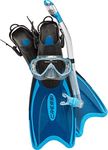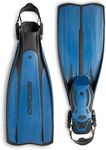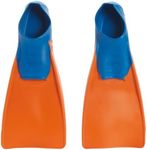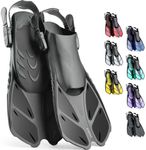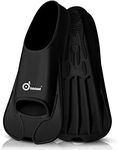Buying Guide for the Best Snorkeling Fins
Choosing the right snorkeling fins can greatly enhance your underwater experience by providing better propulsion, comfort, and control. When selecting snorkeling fins, it's important to consider various factors such as the type of fin, size, material, and design. Understanding these key specifications will help you make an informed decision and ensure that you have a comfortable and enjoyable snorkeling adventure.Type of FinThere are two main types of snorkeling fins: full-foot fins and open-heel fins. Full-foot fins cover your entire foot and are typically more lightweight and easier to put on and take off. They are ideal for warm water snorkeling and for those who prefer a snug fit. Open-heel fins, on the other hand, have an adjustable strap at the back and are designed to be worn with neoprene booties. They offer more versatility and are suitable for both warm and cold water snorkeling. Choose full-foot fins if you prioritize convenience and comfort in warm waters, and opt for open-heel fins if you need more flexibility and plan to snorkel in varying water temperatures.
Fin SizeThe size of the fin is crucial for comfort and efficiency. Fins that are too small can cause discomfort and cramping, while fins that are too large can lead to inefficient kicking and reduced propulsion. To find the right size, refer to the manufacturer's sizing chart and consider trying on the fins with the gear you plan to wear, such as booties for open-heel fins. Your fins should fit snugly without being too tight, allowing for some movement but not slipping off your feet. Properly fitting fins will ensure a comfortable snorkeling experience and optimal performance.
Blade Length and StiffnessThe blade length and stiffness of snorkeling fins affect your propulsion and maneuverability in the water. Shorter blades are easier to control and are ideal for beginners or those who prefer a more relaxed snorkeling experience. Longer blades provide more power and are suitable for stronger swimmers or those who want to cover more distance. Blade stiffness also plays a role; softer blades are more flexible and comfortable, making them suitable for leisurely snorkeling, while stiffer blades offer more power and are better for advanced snorkelers or those who need to navigate strong currents. Consider your swimming strength and snorkeling goals when choosing the blade length and stiffness.
MaterialSnorkeling fins are typically made from materials such as rubber, plastic, or a combination of both. Rubber fins are generally more durable and provide better flexibility, making them comfortable for extended use. Plastic fins are often lighter and more affordable but may not offer the same level of comfort and durability as rubber fins. Some fins combine both materials to balance durability, flexibility, and cost. Choose fins made from a material that suits your comfort preferences and intended use. If you plan to snorkel frequently, investing in higher-quality rubber fins may be worthwhile.
Design FeaturesVarious design features can enhance the performance and comfort of snorkeling fins. Vented blades, for example, reduce drag and increase efficiency by allowing water to flow through the fin. Split fins, which have a split down the middle of the blade, can provide more propulsion with less effort, making them ideal for longer snorkeling sessions. Additionally, ergonomic foot pockets and adjustable straps can improve comfort and fit. Consider which design features align with your snorkeling style and preferences to find fins that will enhance your underwater experience.
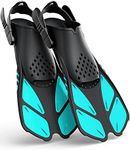


![Cressi Agua (blue) [41/42]](https://images-proxy.bestreviews.guide/2YkGh8Eh4cHqI8_PFqCqW8Su_Ac=/0x150/https://m.media-amazon.com/images/I/41A7VnKlBhL._AC_CX679_.jpg)

